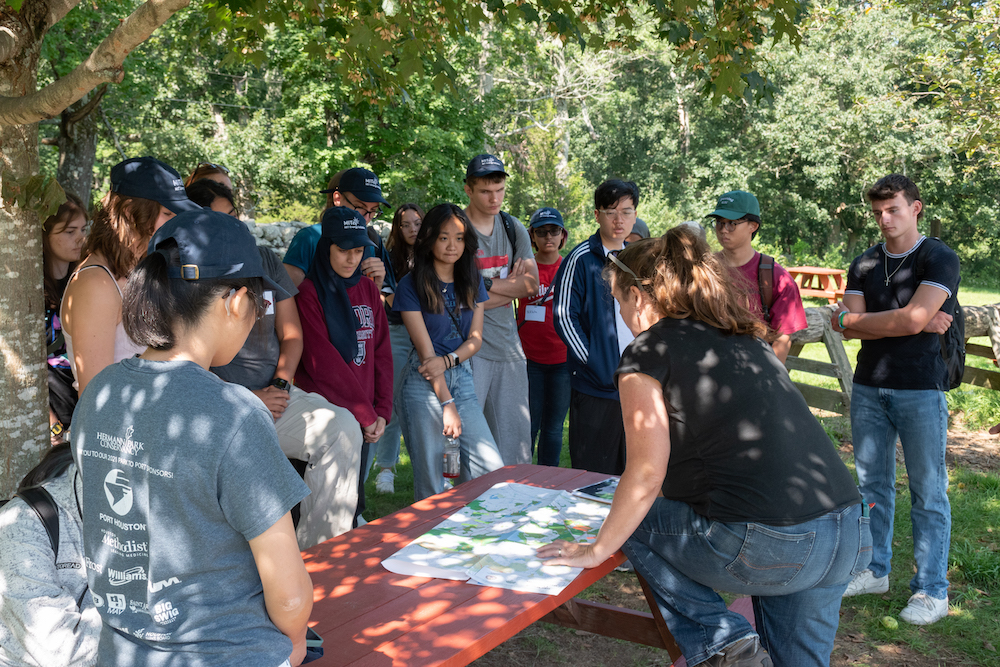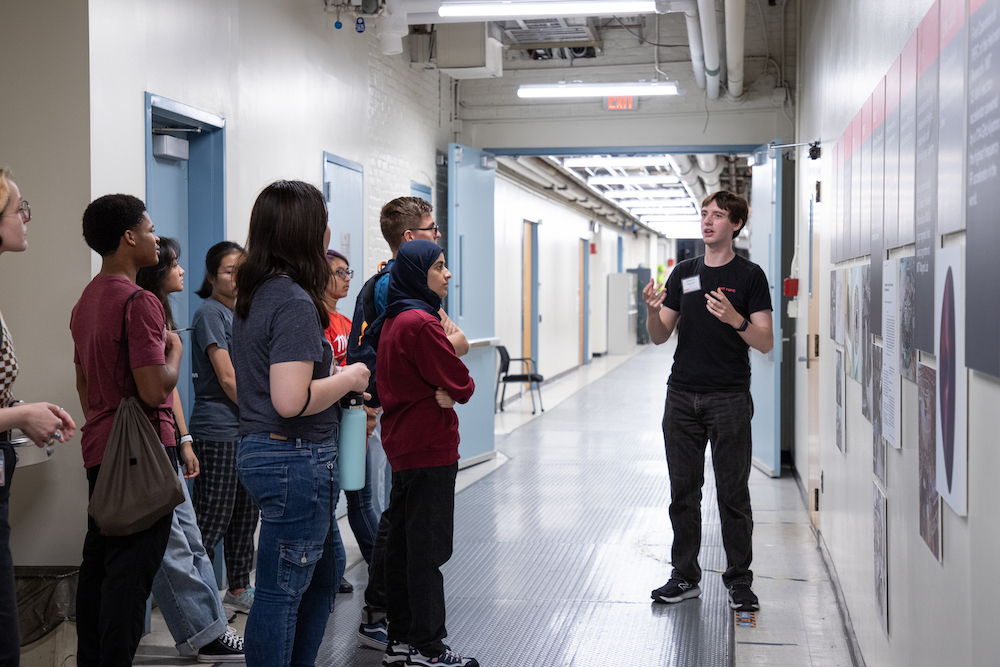
Before they even settle into their new life as MIT students, groups of incoming first-years can attend one of several subject-related pre-orientation sessions to learn about courses and research programs in which they might want to participate. Among those offerings, which took place the week before regular first-year orientation, was a weeklong session called “Discover the Energy Transition,” sponsored by the MIT Energy Initiative (MITEI). Seventeen students took part in that series of events, which included visits to a wind-turbine-blade testing facility, a nuclear reactor, and a sustainable farm, plus a chance to harness wind power themselves for a sail on the Charles River.
“We look at it as a way to get to know new students,” says the program’s director, MITEI Senior Academic Administrator Rowan Elowe, “and introduce them to the energy programs, the wealth of resources and labs, faculty members, courses, and of course our Energy Studies Minor program and some of the other education programs we offer at MITEI.” Elowe, who directed the 13-year-old program this year for the first time, says, “We’re trying to show students MITEI and its many resources in the energy landscape, but also, we really want to show how energy is interconnected across disciplines.”
The activities included a welcome barbecue at Kresge Oval, then four days of visits to labs, testing facilities, and real-world energy-related sites. The visits began with a tour of a large facility in Charlestown where wind turbine blades undergo detailed stress testing simulating years of use in a just a few months. This gave the students a chance to see the mammoth scale of today’s wind turbines.
“I really enjoyed touring the wind turbine testing facility,” says incoming first-year John Dwyer. “It was interesting to see how much work goes into even just testing the structure of a blade, much less the design and construction” of the whole wind farm.

MIT graduate student Zander Keith (right) gave the FPOP students a tour of the Plasma Science and Fusion Center. Credit: Nicole Klaey
Both kinds of nuclear energy were the subject of back-to-back presentations: a tour of the Plasma Science and Fusion Center, where a new kind of potential fusion power generator was developed and spun off into startup company Commonwealth Fusion Systems, and then a tour of MIT’s own fission research reactor.
A student, Trent Lee, presented a summary of work he performed on energy issues last summer through MIT’s Undergraduate Research Opportunities Program (UROP). This gave the incoming students a taste of research opportunities in which they might soon be able to partake, but also gave the presenting student practice before he had to present his work at MITEI’s Annual Research Conference.
Mike Howland, the Esther and Harold E. Edgerton Assistant Professor of Civil and Environmental Engineering, gave a talk about the benefits of fine-tuning how existing wind farms are operated. His research highlights how adjusting individual turbines to minimize the wind disruption to turbines further downwind increases the facility’s overall power output with no change to existing hardware.
“Personally, as someone planning to major in physics, my favorite part [of the week’s activities] was learning about modeling the interaction between separate wind turbines to increase their overall efficiency,” says first-year student Borna Perković.
The group also traveled to Lincoln, Massachusetts, to tour Codman Farm, which has been implementing a wide variety of methods to reduce its overall carbon footprint, including a large solar array providing most of the farm’s power, solar water heaters, and efficient farming methods to reduce waste that can generate greenhouse gases. Perković says that among the students this farm tour was “probably the majority’s favorite, because it showed how, with resourcefulness and patience, small steps can go a long way.”
Janelle Knox-Hayes, an MIT professor of economic geography and planning, spoke to the group about her research, which includes energy access and indigenous people’s rights and stakeholder engagement in the creation of equitable, sustainable energy projects. The program also featured two MIT faculty members who were organizing a discussion about climate change between a faculty member and an MIT alum with differing views on the severity of the problem, but who stress the importance of civil dialog about such important issues and are planning a public debate on the subject.
Elowe explains that he wanted to have the organizers talk about preparing for that debate so that students could see “how they’re planning to facilitate that, what they could expect to see, and how they can navigate these kinds of conversations on their own.” He said students were surveyed before the program began and were asked what they worried about most. “A lot of them were worried about the political divide in the United States and the heavily politicized discourse,” he says. Because climate change is one of these heavily politicized topics, he says the upcoming program of debates should help to address this concern.

First order of business for the weeklong Discover Energy FPOP program: The students met with their counselor for introductions, taking the opportunity to get to know each other as well as a little more about MIT. Pictured left to right: Emma Hopkins, Samuel Zhou, Ruoxi Qian, Celestina Pint, Maria Alder. Credit: Charlotte Whittle
A few events were just for fun, intended to encourage bonding among the group of newly arrived students, along with some faculty and staff members. The group experienced firsthand the power of the wind by sailing some of Community Boating’s fleet of small sailboats on the Charles River alongside campus—enjoying one of humanity’s oldest forms of sustainable transportation. Participants also spent one afternoon riding bikes on some of the area’s bike trails and learning how to rent bikes from the services that provide them and how to maintain their own bikes—another traditional and climate-friendly way to get around.
They also toured a facility where MIT’s Electric Vehicle Team, the oldest of its kind in the nation, is in the process of building and testing an innovative hydrogen fuel-cell electric motorbike.
Overall, Elowe says, a survey of the students afterward showed “ultimately everyone was really pleased with the week” and with its balance of lectures and hands-on events and tours. Some of the students have already volunteered to come back next year to help with the tours and events, he says.
“If we can recruit more students to the Energy Studies Minor program, that’s wonderful,” he says. “The goal of the minor is to have anyone who’s working in a field proximate to energy understand how energy is a lever for climate change mitigation and to understand how in whatever role they choose to follow in their profession, they’re able to have a positive impact.”
Whichever majors or minors these students ultimately choose, he says, just knowing about MITEI and the Energy Studies Minor and having had this introduction to the topics, “I’d be happy to know that they’re just keeping it in the back of their minds, how they can positively impact climate change and reduce carbon emissions, in any way they can, in whatever role they work.”
Looking back on the week’s events, Dwyer says, “Overall, it was an amazing and extremely valuable experience that I am grateful to have had the opportunity to partake in. It got me excited to be a part of the MIT community, and MITEI, too!”
This article appears in the Winter 2024 issue of Energy Futures.